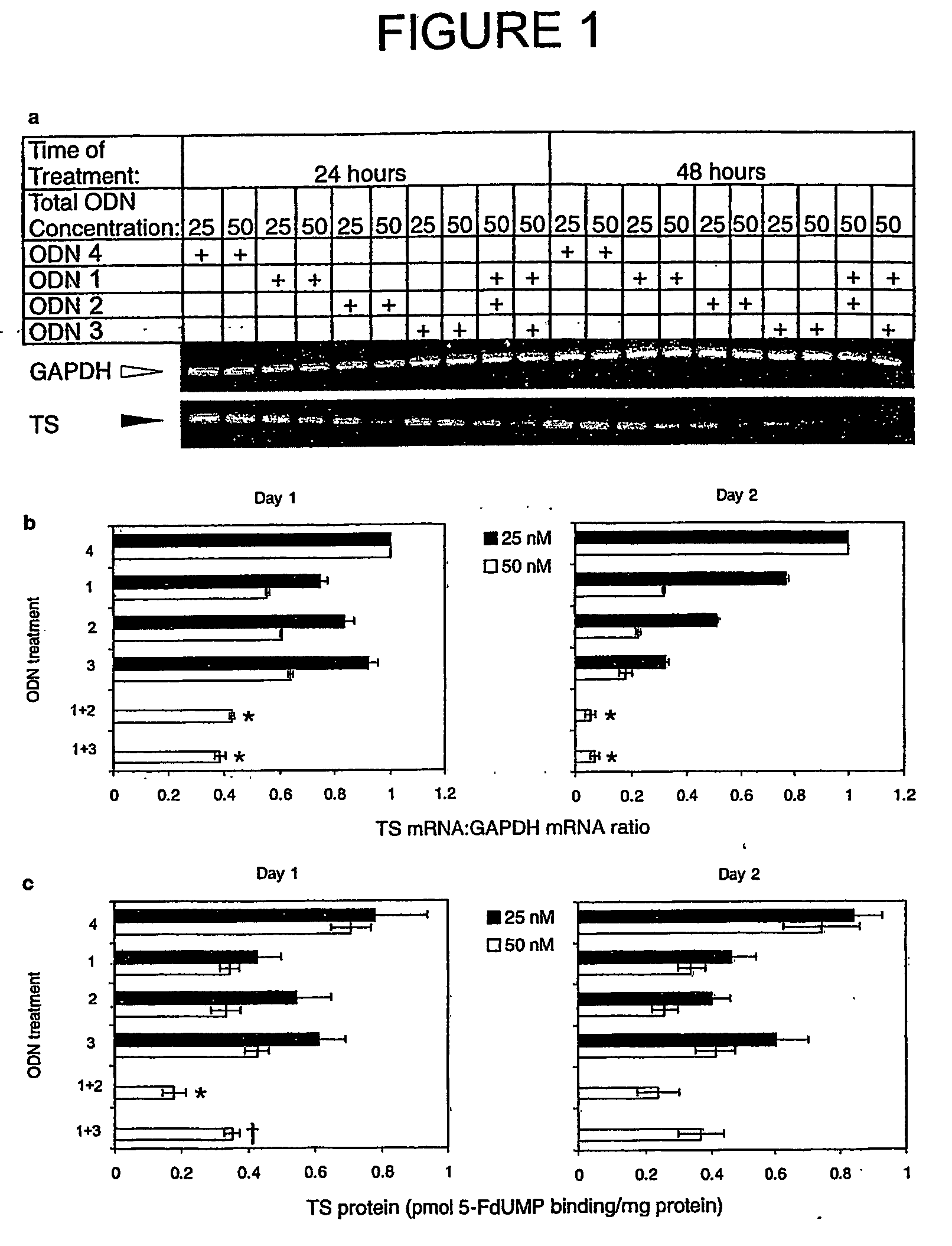Combinations of antisense oligonucleotides directed against thymidylate synthase mrna and uses thereof
a technology of thymidylate synthase and antisense oligonucleotides, which is applied in the field of antisense oligonucleotides for use in cancer therapies, can solve problems such as dose-limiting toxicity, and achieve the effects of reducing the amount of chemotherapeutics, enhancing the anti-tumour effect of standard doses, and effectively treating mammal with cancer
- Summary
- Abstract
- Description
- Claims
- Application Information
AI Technical Summary
Benefits of technology
Problems solved by technology
Method used
Image
Examples
example 1
ODN Combinations Enhance Antisense Downregulation of TS
[0141] To test the hypothesis that combinations of antisense ODNs might be more effective than single ODNs, several pairs of antisense ODNs targeting human TS mRNA were analyzed for their effects on HeLa cells in vitro. TS antisense ODN 1, used alone, effectively inhibits HeLa cell proliferation compared to the scrambled control ODN 4 (Table 3) (Ferguson et al., 1999, Br. J. Pharmacol. 127:1777-1786). In initial experiments, ODN 1 (50 nM) was combined with equimolar amounts of one of a panel of antisense ODNs targeting different regions of TS mRNA, and the results compared to those obtained when ODN 1 was combined with control ODN 4 (an ODN that does not target TS mRNA or any other known human sequences). Certain partner ODNs enhanced the antiproliferative response while others did not (Table 3); subsequent experiments focussed on treatment with ODN 1 in combination with ODN 2 or 3.
[0142] HeLa cells were treated with these pai...
example 2
Antisense ODN Combinations Exhibit Enhanced Antiproliferative Activity
[0143] Inhibition of HeLa cell proliferation by ODN 1 treatment has previously been shown to be accompanied by transient G2 / M cell cycle arrest (Berg et al., 2001, J. Pharmacol. Exp. Ther. 298:477-484). To assess the ability of ODN combinations to induce cell cycle arrest, a flow cytometric analysis was used. FIG. 2 shows that a 48-hour treatment with ODN 1 alone or with the combination of ODNs 1+2 induced G2 / M arrest to a similar extent, but that ODN 2 alone had no significant effect on the cell cycle profile. ODN 2 is representative of several other TS antisense ODNs that, when used as single agent treatments, had little or no dose-dependent effects on cell cycle or cell proliferation but effectively enhanced the cytotoxicity of raltitrexed and 5-FUdR (P. Ferguson and R. Berg, unpublished observations).
[0144] The ODN combinations were then examined for the ability to inhibit HeLa cell proliferation over a rang...
example 3
Antisense ODN Combinations Chemosensitize HeLa Cells to Anti-TS Drugs
[0145] The capacity of combinations of TS antisense ODNs to inhibit proliferation more effectively than individual ODNs raised the possibility that ODN combinations would similarly be more effective in enhancing tumour cell sensitivity to TS-targeting drugs. Therefore, the ability of these combinations of ODNs to enhance the sensitivity of HeLa cells to the TS inhibitors raltitrexed and 5-FUdR was examined. Compared to treatment with the control scrambled ODN 4, treatment with the combinations of ODNs 1+2 and ODNs 1+3 increased the cytotoxicity of raltitrexed (FIG. 4A) and 5-FUdR (FIG. 4B). However, the degree of enhancement was not different than that achieved by treatment with ODN 1 alone.
[0146] It was hypothesized that the observed lack of differential chemosensitizing effects between individual and combination ODNs might be related to the ODN concentration at which testing was done. That is, if cells were tre...
PUM
| Property | Measurement | Unit |
|---|---|---|
| concentration | aaaaa | aaaaa |
| volumes | aaaaa | aaaaa |
| concentrations | aaaaa | aaaaa |
Abstract
Description
Claims
Application Information
 Login to View More
Login to View More - R&D
- Intellectual Property
- Life Sciences
- Materials
- Tech Scout
- Unparalleled Data Quality
- Higher Quality Content
- 60% Fewer Hallucinations
Browse by: Latest US Patents, China's latest patents, Technical Efficacy Thesaurus, Application Domain, Technology Topic, Popular Technical Reports.
© 2025 PatSnap. All rights reserved.Legal|Privacy policy|Modern Slavery Act Transparency Statement|Sitemap|About US| Contact US: help@patsnap.com



